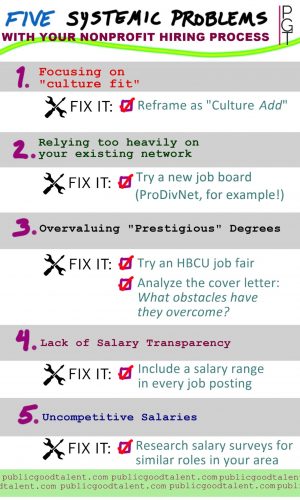Hard truth: Hard work is not enough to land top-level talent. As an organizational leader, recruiting amazing team members requires taking a deep look at your nonprofit recruitment process. You must identify systemic problems that need fixing. This is especially important if you value building a diverse team that represents the community you serve, as all nonprofit leaders should. We put together a short list of common systemic problems that we see in our Denver-based office.
Problem #1: You’re searching for a “culture fit” Instead of a “culture add”
When making hiring decisions, it’s fine to ask yourself, “Will this candidate’s personality work with the rest of my team?” But be wary. Too often in nonprofit recruitment, “culture fit” is code for “someone exactly like us.” Diversity is good for organizational culture, and it’s good for business. Sure, it’s easier to onboard someone who already thinks, looks, and acts like everyone else on your team. But will it help push your organization forward? Probably not.
Fix it: Reframe your search in terms of “culture add.” Ask yourself, “What can this candidate give us that we don’t already have? What unique experience or perspective do they bring? How can they serve our community in a way that we don’t already?”
Problem #2: You’re relying too heavily on your existing network
“The best employees are referrals.” We’ve all heard this, and there is some truth to it. But similar to Problem #1, you must ask yourself whether you are overvaluing ease of onboarding at the expense of adding diverse perspectives and new skills. Relying too heavily on your own network (or the network of your staff) is a surefire way to amass a candidate pool that represents you. Instead, it should represent your community or your customers.
Fix it: Post to a different job board. As Einstein said, stop doing the same thing and expecting different results. In the world of nonprofit recruitment, it pays to switch it up. We highly recommend Professional Diversity Network as a platform for diverse talent.
Problem #3: You’re overvaluing candidates from “prestigious” schools
At PGT, climbing Colorado mountains is one of our favorite pastimes. It feels good to stand on top of a peak. But what if I just drove to the top of Mount Evans? Sure, I’d get an amazing view from over 14,000 feet, but it would be less fulfilling (and less impressive) than if I climbed it carrying a heavy backpack. You should look at candidates through a similar lens.
To continue the analogy, not everyone begins their journey at the same academic trailhead. If one candidate climbs a 12,000 foot peak with old sneakers and a backpack of food for their entire family, is their feat less impressive than a candidate who drove up a paved road to the top of a 14,000 foot peak? Of course not! At Public Good Talent, we place a lot of value on grit and resilience when leading a nonprofit recruitment search.
Fix it: Quit going to the same university job fairs every year. This year, try boothing at a Historically Black College or University (HBCU).
Bonus Fix: Pay more attention to cover letters. Ask yourself, “What obstacles did this person overcome to get here?”
Problem #4: You’re not being transparent with your salary range

Controversial, but true: Including a salary range in your job posting is the smart and ethical thing to do. It saves you time, because you avoid spending weeks interacting with a candidate only to discover that their desired range is way out of your league. It saves your reputation, because you avoid the trash-talk that inevitably ensues after you string a candidate along and then crush their dreams. Looking for a job is hard. Don’t make candidates’ lives even more difficult by hiding your budget.
And it gets results! Job openings with a posted salary receive MORE applications than opening without a salary. If you think hiding your salary range will get your more applicants, think again.
Fix it: Include a salary range with every single job posting.
Problem #5: Your salary is not competitive
There are a small – VERY small – handful of nonprofit organizations that can land high-level staff at below market salaries. Odds are, you’re not one of them. Amazing culture, meaningful work, nice benefits – these are the icing on the cake, but they do NOT make up for a low salary. Here’s the fact: Even in the nonprofit sector, it is nearly impossible to land an amazing team member if you do not pay a competitive wage.
Fix it: Do your research, and make sure you are offering fair and competitive salaries. Most states have at least one organization that publishes an annual salary survey, and it often includes specific data for the nonprofit sector. Here in Colorado, Employers Council puts out an amazing resource.
Public Good Talent is a boutique recruitment firm serving nonprofits and small businesses who are working to improve their communities. Based in Denver, Colorado, PGT serves organizations across the country.

Comments are closed.